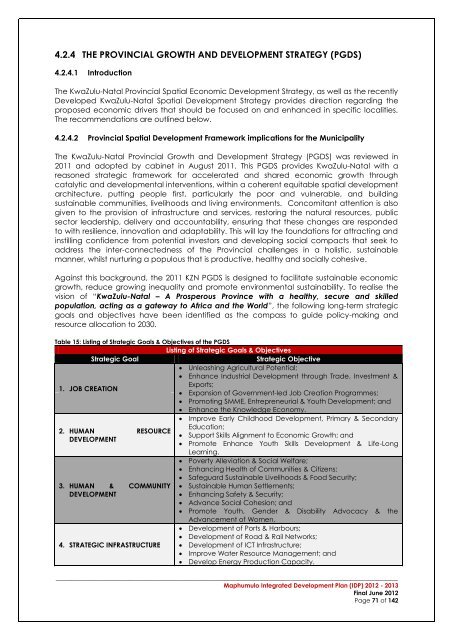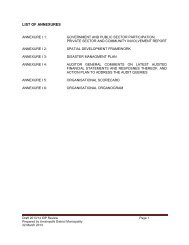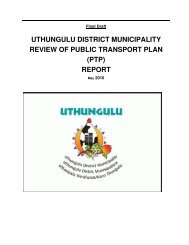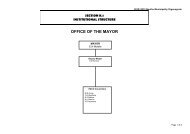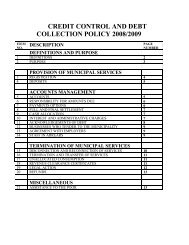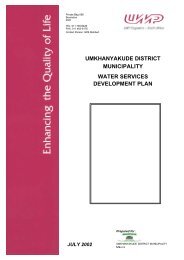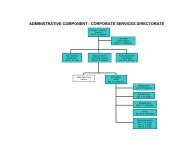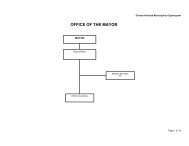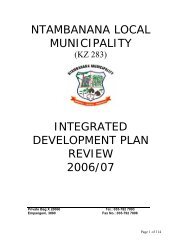Maphumulo IDP - KZN Development Planning
Maphumulo IDP - KZN Development Planning
Maphumulo IDP - KZN Development Planning
You also want an ePaper? Increase the reach of your titles
YUMPU automatically turns print PDFs into web optimized ePapers that Google loves.
4.2.4 THE PROVINCIAL GROWTH AND DEVELOPMENT STRATEGY (PGDS)4.2.4.1 IntroductionThe KwaZulu-Natal Provincial Spatial Economic <strong>Development</strong> Strategy, as well as the recentlyDeveloped KwaZulu-Natal Spatial <strong>Development</strong> Strategy provides direction regarding theproposed economic drivers that should be focused on and enhanced in specific localities.The recommendations are outlined below.4.2.4.2 Provincial Spatial <strong>Development</strong> Framework implications for the MunicipalityThe KwaZulu-Natal Provincial Growth and <strong>Development</strong> Strategy (PGDS) was reviewed in2011 and adopted by cabinet in August 2011. This PGDS provides KwaZulu-Natal with areasoned strategic framework for accelerated and shared economic growth throughcatalytic and developmental interventions, within a coherent equitable spatial developmentarchitecture, putting people first, particularly the poor and vulnerable, and buildingsustainable communities, livelihoods and living environments. Concomitant attention is alsogiven to the provision of infrastructure and services, restoring the natural resources, publicsector leadership, delivery and accountability, ensuring that these changes are respondedto with resilience, innovation and adaptability. This will lay the foundations for attracting andinstilling confidence from potential investors and developing social compacts that seek toaddress the inter-connectedness of the Provincial challenges in a holistic, sustainablemanner, whilst nurturing a populous that is productive, healthy and socially cohesive.Against this background, the 2011 <strong>KZN</strong> PGDS is designed to facilitate sustainable economicgrowth, reduce growing inequality and promote environmental sustainability. To realise thevision of “KwaZulu-Natal – A Prosperous Province with a healthy, secure and skilledpopulation, acting as a gateway to Africa and the World”, the following long-term strategicgoals and objectives have been identified as the compass to guide policy-making andresource allocation to 2030.Table 15: Listing of Strategic Goals & Objectives of the PGDSListing of Strategic Goals & ObjectivesStrategic GoalStrategic Objective Unleashing Agricultural Potential; Enhance Industrial <strong>Development</strong> through Trade, Investment &Exports;1. JOB CREATION Expansion of Government-led Job Creation Programmes; Promoting SMME, Entrepreneurial & Youth <strong>Development</strong>; and Enhance the Knowledge Economy. Improve Early Childhood <strong>Development</strong>, Primary & SecondaryEducation;2. HUMAN RESOURCE Support Skills Alignment to Economic Growth; andDEVELOPMENT Promote Enhance Youth Skills <strong>Development</strong> & Life-LongLearning.3. HUMAN & COMMUNITYDEVELOPMENT4. STRATEGIC INFRASTRUCTURE Poverty Alleviation & Social Welfare; Enhancing Health of Communities & Citizens; Safeguard Sustainable Livelihoods & Food Security; Sustainable Human Settlements; Enhancing Safety & Security; Advance Social Cohesion; and Promote Youth, Gender & Disability Advocacy & theAdvancement of Women. <strong>Development</strong> of Ports & Harbours; <strong>Development</strong> of Road & Rail Networks; <strong>Development</strong> of ICT Infrastructure; Improve Water Resource Management; and Develop Energy Production Capacity.__________________________________________________________________________________________<strong>Maphumulo</strong> Integrated <strong>Development</strong> Plan (<strong>IDP</strong>) 2012 - 2013Final June 2012Page 71 of 142


